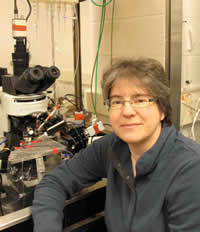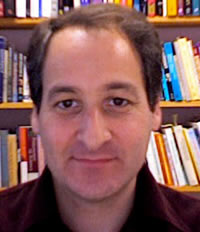 |
C O N F E R E N C E Thu 26 April - Sat 28 April 2012 |
Workshops
 |
 |
||
| Dr. Deda Gillespie | Dr. Dan Goldreich | ||
The Physics of the Nervous System |
|||
Students are often unaware of the importance of physics to a variety of fields in the Life Sciences including Neuroscience. Using a combination of lecture presentation and demonstrations, we will describe the physics that underlies the nervous system's ability to perceive through touch, hearing, and vision.
Additional information related to our topic: http://psych.mcmaster.ca/neuroclassics/OAPT.html |
|||
Deda Gillespie is an assistant professor at McMaster University in the Department of Psychology, Neuroscience & Behaviour. She has a BS (Biology) from Yale University and a PhD (Neuroscience) from UCSF. Her research focuses on how the developing brain establishes appropriate connections between neurons in order to create neural circuits for efficient auditory processing. The lab's principal technique is patch electrophysiology, which is used to record electrical signals from individual neurons. Optical methods for physiology include ion-imaging and photo-stimulation of neurons. The lab uses various non-physiological imaging techniques to study, for example, protein expression and neuronal morphology. Dr. Gillespie teaches in the Honours Integrated Science Program; as her own research field is highly interdisciplinary, she encourages biology students to acquire strong backgrounds in the physical sciences and she enjoys introducing physical science students to the exciting field of neuroscience. |
|||
Dan Goldreich is an associate professor in the Department of Psychology, Neuroscience & Behaviour at McMaster University. He received a BS in physics from the University of California, San Diego (1986) and a PhD in neuroscience from the University of California, San Francisco (1994). While studying physics as an undergrad, Dan was drawn to the question of how our senses interface with physical stimuli in order to perceive the external world. Specialized sensory receptors in the eye, ear, mouth, nose, and skin transform physical stimuli into patterns of electrical impulses that travel rapidly along chains of nerve fibers to reach the brain - a sort of imprecise neural Morse code. The brain then somehow decodes these neural impulse patterns to construct a perception of the world. But how? Focusing on the sense of touch, Dan's research suggests that the brain uses probabilistic reasoning (Bayesian inference) to generate perceptual best guesses, optimally combining the imprecise information carried by neural impulses with relevant knowledge of the world. Drawing on his physics background, Dan enjoys designing and constructing novel equipment to test the sense of touch. He also loves teaching neuroscience; in the classroom, he engages students with demonstrations that reveal the remarkable physical properties of the nervous system. |
|||